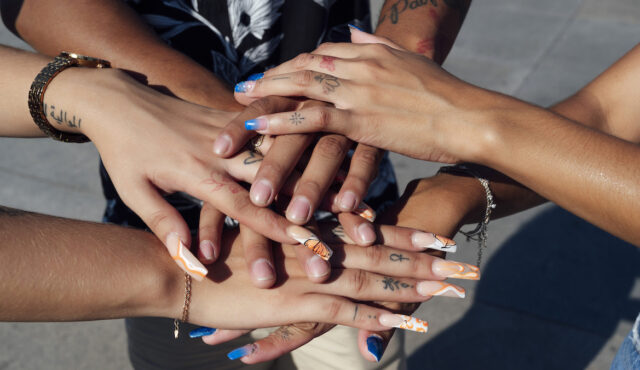Here’s the thing, though: Even though I only use press-ons a couple of times a month (if that), my thumbnails look permanently altered as a result—which apparently a side effect of press-ons that many people experience. I chatted with two nail experts to find out why.
Why do I suddenly have dents in my thumbnails after press-ons?
While my pinkies, ring fingers, middle fingers, and pointer fingers all look perfectly fine post-press-ons, my thumbs look dented and ridged—to the point that I now refer to them as dinosaur nails because they remind me of an armored Ankylosaurus.
According to Dana Stern, MD, a board-certified dermatologist who specializes in nails and the founder of nailcare line Dr. Dana Nails, these dents are common with press-on use. “A series of dents or transverse grooves in the nail is usually due to trauma to the nail matrix, which is the region of the nail that produces what we refer to as the nail,” she explains. “Part of the matrix can usually be seen on the thumbnail as the half moon or lunula.”
While all nails have a matrix, Dr. Dana says that the thumbnail has the largest matric of all the fingernails and it is thus more susceptible to damage.
“Any repetitive pushing back at the cuticle, which directly overlies the matrix, can result in trauma to the matrix and result in the new nail growing out with dents,” she says. “The reason that this occurs with press-ons is because they push against the cuticle and damage the nail matrix. It happens more often on the thumbnail because it has the largest matrix of the fingernails and requires the largest press-on nail, which exerts the largest force and is therefore the most potentially damaging.”
In addition to how we apply our press-on nails, how we remove them can affect our nail plates, too. “People tend to underestimate the potential damage that can arise from improper removal of nail enhancements,” says Mazz Hanna, celebrity manicurist and CEO of Nailing Hollywood. “When you pick or rip off a press-on nail you are likely taking a layer of your nail plate with it. This can damage the nail and ultimately disrupt the growth cycle, which may lead to ridging.” And the more often you repeat the process, the more damaged your nail plate becomes.
How long do these dents last?
Considering I apply press-ons every few weeks, my thumbnails feature several spaced-out dents from the cuticle to the tip of my nail. While the dents aren’t immediately visible post-removal, Dr. Dana says that they typically show up in one to two months following the trauma. Thankfully, she assures us that the dents typically aren’t permanent—they grow out. “It takes six months to replace a typical adult fingernail,” she says.
How to prevent the dents
Since thumbnail dents are a direct result of irritating the cuticle and the underlying nail matrix, it’s important to be more gentle when applying press-ons. For example, I usually firmly hold each press-on in place for 20 to 30 seconds to ensure it’s adhered. Typically, I hold my thumbnails on a bit longer and with a touch more pressure since it’s the largest nail, not to mention a finger I use even more regularly in daily life. Now that I know why my thumbnails are denting, though, I’ll be more mindful about how hard I press my nails on.
“Go easy with anything near the cuticle,” encourages Dr. Dana encourages. “Whether it’s pushing back the cuticle or pushing a press-on into place, try to do it gingerly to prevent damage to the matrix.”
Additionally, she suggests allowing current dents to grow out before applying new nails, otherwise you run the risk of developing multi-ridged nails like mine. At the end of the day, though, it’s largely just a cosmetic concern, so it’s up to you when you want to experiment with your next set of pressies.
And remember: The way you remove your press-ons matters, too. “The best way to avoid damaging your nails is with proper removal,” Hanna says. “I always recommend following the manufacturer’s instructions for removal, but I do have a few products and methods that I frequently turn to for this. Static Nails Pop On Remover is my go-to product. The bottle is as functional as it is elegant—the built-in dropper makes application easy. Just apply a few drops and after a few minutes the nails will slide right off—even if they are glued on. Dashing Diva Magic Off is another great product for this.” (Since these products often sell out, you may also want to consider the Olive & June Press-On Nail Polish Remover Kit as an alternative).
Our editors independently select these products. Making a purchase through our links may earn Well+Good a commission.











